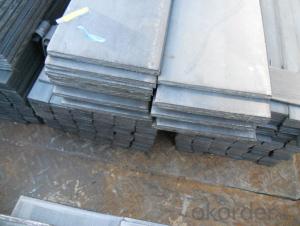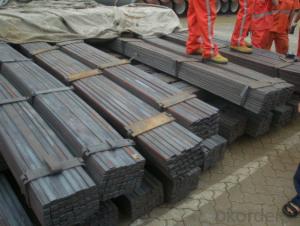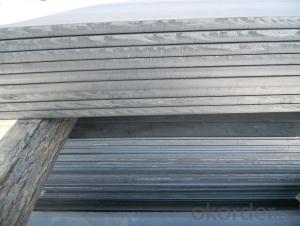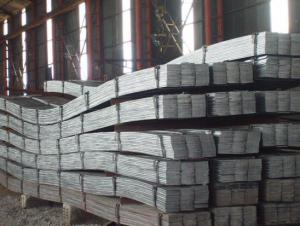Slit Cutting Flat Bar in Material Grade Q235B Steel Flat Bars
- Loading Port:
- Tianjin
- Payment Terms:
- TT or LC
- Min Order Qty:
- 25 m.t
- Supply Capability:
- 10000 m.t/month
OKorder Service Pledge
OKorder Financial Service
You Might Also Like
OKorder is offering high quality Slit Cutting Flat Bar at great prices with worldwide shipping. Our supplier is a world-class manufacturer of steel, with our products utilized the world over. OKorder annually supplies products to European, North American and Asian markets. We provide quotations within 24 hours of receiving an inquiry and guarantee competitive prices.
Product Applications:
Slit Cutting Flat Bars are ideal for structural applications and are widely used in the construction of buildings and bridges, and the manufacturing, petrochemical, and transportation industries.
Product Advantages:
OKorder's Slit Cutting Flats Barare durable, strong, and resist corrosion.
Main Product Features:
· Premium quality
· Prompt delivery & seaworthy packing (30 days after receiving deposit)
· Corrosion resistance
· Can be recycled and reused
· Mill test certification
· Professional Service
· Competitive pricing
Product Specifications:
Manufacture: Slit Cutting
Grade: Q195 – 235
Certificates: ISO, SGS, BV, CIQ
Length: 6m – 12m, as per customer request
Packaging: Export packing, nude packing, bundled
Chemical composition of Q235
Alloy No | Grade | Element(%) | ||||
C | Mn | S | P | Si | ||
Q235 | B | 0.12-0.20 | 0.3-0.7 | ≤0.045 | ≤0.045 | ≤0.3 |
Physical properties of Q235
Alloy No | Grade | Yielding strength point(Mpa) | Tensile strength (Mpa) | Elongation after fracture(%) | ||||||
Thickness (mm) | Thickness (mm) | |||||||||
≤16 | >16--40 | >40--60 | >60--100 | ≤16 | >16--40 | >40--60 | >60--100 | |||
≥ | ≥ | |||||||||
Q235 |
B |
235 |
225 |
215 |
205 |
375--500 |
26 |
25 |
24 |
23 |
Images:


- Q: What is the tolerance for thickness in steel flat bars?
- The tolerance for thickness in steel flat bars can vary depending on the specific standards and specifications set by the manufacturer or industry. However, in general, the tolerance for thickness in steel flat bars is typically specified within a range of +/- a certain measurement, such as +/- 0.005 inches or +/- 0.13 millimeters. This tolerance ensures that the thickness of the steel flat bars remains within an acceptable range and meets the required dimensional specifications.
- Q: What are the fire-resistance properties of steel flat bars?
- Steel flat bars have excellent fire-resistance properties. Due to their high melting point, steel bars can withstand high temperatures without losing their structural integrity. In the event of a fire, steel bars do not burn or contribute to the spread of flames, making them a reliable choice for fire-resistant structures. Additionally, steel bars have low thermal conductivity, meaning they do not easily transfer heat, further enhancing their fire-resistance. Overall, steel flat bars are highly resistant to fire and are widely used in construction projects where fire safety is a priority.
- Q: Can steel flat bars be used for tool and die making?
- Tool and die making necessitates the utilization of robust and enduring materials capable of enduring the rigorous pressures and temperatures associated with manufacturing. In light of their exceptional strength-to-weight ratio and resistance to deterioration, steel flat bars are frequently preferred for this purpose. These bars can be effortlessly machined, formed, and strengthened to meet the exact specifications of the fabricated tool or die. Moreover, steel flat bars are easily accessible in a variety of dimensions and grades, rendering them a versatile option for tool and die making applications.
- Q: What is the difference between carbon steel and mild steel flat bars?
- Both carbon steel and mild steel flat bars are commonly used in construction and manufacturing, but they have some distinct differences. Firstly, the carbon content sets them apart. Carbon steel contains a higher percentage of carbon, typically ranging from 0.30% to 1.70%, while mild steel has a lower carbon content, usually around 0.05% to 0.25%. Carbon steel's elevated carbon content gives it superior strength and hardness, making it suitable for applications requiring high durability and strength. Another distinguishing factor is the level of impurities present in the steel. Mild steel has fewer impurities, making it more malleable and easier to work with. It can be effortlessly welded, formed, and machined, making it a popular choice in various manufacturing processes. Conversely, carbon steel may contain higher impurity levels, resulting in increased difficulty during work and necessitating specialized tools and techniques. The final disparity lies in the cost. Generally, mild steel is less expensive than carbon steel. This is because mild steel has a lower carbon content and fewer impurities, making it easier and more readily available to produce. On the other hand, carbon steel demands more processing and refining, contributing to its higher price tag. In summary, the primary distinctions between carbon steel and mild steel flat bars are their carbon content, impurity levels, and cost. Carbon steel possesses a higher carbon content and potentially more impurities, which leads to greater strength and hardness. Conversely, mild steel has a lower carbon content and is more malleable and easy to work with. Additionally, mild steel is generally cheaper than carbon steel.
- Q: What are the common finishes for steel flat bars?
- Steel flat bars can be finished in several ways, each serving a specific purpose. The most basic finish is achieved by heating the steel to a high temperature and then rapidly cooling it, resulting in a rough, industrial look with visible mill scale. Another common finish involves passing the steel through rollers at room temperature to achieve a smoother and more refined surface. This is typically used when a more aesthetically pleasing appearance is desired. To protect against corrosion, steel flat bars can be coated with a layer of zinc, acting as a barrier against moisture and other corrosive elements. Alternatively, steel flat bars can be treated with a painted or powder coated finish, providing both protection against corrosion and a wide range of color options. This makes them suitable for various architectural and decorative applications. Lastly, steel flat bars can be polished to achieve a reflective, mirror-like finish. This is often used in decorative applications where a high-end, luxurious appearance is desired. In conclusion, the choice of finish for steel flat bars depends on the intended use and desired aesthetic outcome.
- Q: Can steel flat bars be easily machined or drilled?
- Yes, steel flat bars can be easily machined or drilled with the appropriate tools and techniques.
- Q: Are steel flat bars suitable for making furniture?
- Yes, steel flat bars are suitable for making furniture. Steel is a strong and durable material that can withstand heavy weight and provide stability to furniture pieces. Steel flat bars can be used to create various furniture items such as tables, chairs, shelves, and frames. They offer a sleek and modern aesthetic and can be easily incorporated into different design styles. Additionally, steel is resistant to rust and corrosion, making it a long-lasting and low-maintenance option for furniture. Overall, steel flat bars provide the necessary strength, stability, and versatility required for furniture making.
- Q: Why is it better to use round steel than that of flat steel in lightning protection?
- From the cross section, thermal stability as long as meet the discharge current can be, but from the lightning protection downlead selection, selection of round steel in order to prevent the tip discharge, so we generally do not choose flat edges as grounding, buried in the earth round and not flat how much difference, but in the same section of the case, of course, the contact area of flat steel and soil are large, relatively scattered large flow area, the construction is more convenient, in terms of price, we are willing to use flat, as for the problem of anti-corrosion, anti-corrosion paint, zinc can be taken, you know the thickness of galvanized steel pipe is generally not flat, so it really depends on the term for the use of galvanized flat steel is not bad.
- Q: How do steel flat bars compare to other types of steel sections?
- Steel flat bars, known for their strength and durability, have a larger surface area due to their flat shape. This results in better load distribution and resistance to bending and twisting, making them ideal for construction, industrial machinery, and transportation infrastructure. Another advantage of steel flat bars is their ease of fabrication and customization. They can be easily cut, welded, and shaped to meet specific design requirements. This makes them suitable for building frameworks, supports, decorative elements, and furniture. Furthermore, steel flat bars are cost-effective compared to other steel sections. They are more affordable than I-beams or angles, making them popular for projects with budget constraints or when large quantities of steel are needed. In terms of versatility, steel flat bars come in various sizes, thicknesses, and grades. They can be used as structural elements, bracing, connectors, or as a base for other components. Their simple design also makes them easy to handle and install, saving time and labor costs. However, it is important to note that steel flat bars may not be suitable for all applications. Their flat shape may limit their load-bearing capacity compared to specialized steel sections like channels or hollow sections. Additionally, their exposed edges may be prone to corrosion, requiring regular maintenance. Overall, steel flat bars provide a combination of strength, versatility, and cost-effectiveness that makes them a popular choice in various industries. They are reliable and efficient options for construction and manufacturing projects, with the ability to withstand heavy loads, ease of fabrication, and affordability.
- Q: Can lightning protection earthing steel bar be directly welded with thread steel?
- Steel is known as hot rolled ribbed bar. Ordinary hot rolled steel bars are made up of HRB and the minimum yield point of the brand. H, R, and B are the first letters in English for hot-rolled (Hotrolled), ribbed (Ribbed) and reinforced (Bars) three words. Hot rolled ribbed bar is divided into two levels, HRB335 (old No. 20MnSi), three HRB400 (20MnSiV, 20MnSiNb, old No. 20Mnti), four grade HRB500 three grade.
Send your message to us
Slit Cutting Flat Bar in Material Grade Q235B Steel Flat Bars
- Loading Port:
- Tianjin
- Payment Terms:
- TT or LC
- Min Order Qty:
- 25 m.t
- Supply Capability:
- 10000 m.t/month
OKorder Service Pledge
OKorder Financial Service
Similar products
Hot products
Hot Searches
Related keywords






























